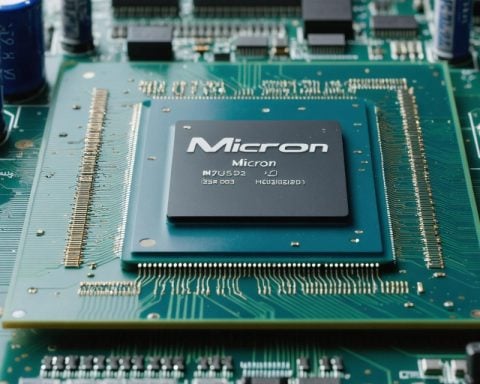- Major American pharmaceutical companies are increasingly partnering with Chinese firms, with nearly 30% of large pharma deals in 2024 involving Chinese entities.
- Chinese advancements in developing cost-effective molecules and rapid trial capabilities attract U.S. companies seeking new breakthroughs.
- As the U.S. emphasizes protectionism in tech sectors, biopharma companies explore innovative business models to integrate Chinese innovations through licensing.
- The trend raises questions about its potential impact on U.S. biotech startups and the overall pharmaceutical landscape.
- Companies like Pfizer are adapting strategies, focusing on oncology and maintaining robust growth amid market uncertainties.
- This cross-Pacific collaboration highlights a possible redefinition of global healthcare innovation, blending Eastern and Western approaches.
A shift erupts within the corridors of major American pharmaceutical companies as they increasingly turn their gaze toward China, seeking the next wave of groundbreaking medicines. In a striking reversal of prior trends, nearly 30% of large pharmaceutical deals in 2024 involved Chinese counterparts, marking a significant uptick from previous years. Why are these pharmaceutical giants suddenly entranced by China? The answer lies in their burgeoning ability to develop effective and affordable molecules, then swiftly usher them into human trials.
As American policymakers chart a course through protectionist waters, notably in technology sectors like AI and semiconductors, biopharma companies are blazing an alternative path. They’re crafting ingenious business models to effectively import Chinese pharmaceutical advances via licensing agreements. Venture funding is drying up in China, further propelling these companies into the eager arms of Western partnerships.
This burgeoning cross-Pacific collaboration raises pivotal questions for the U.S. biotech landscape. Will these alliances drain vitality from domestic startups, or will the sharpened competition invigorate the industry? This burgeoning trend could metamorphose the American pharmaceutical landscape, and no one can quite predict its full impact yet.
Meanwhile, companies like Pfizer are recalibrating their strategies. In the U.S., they are forging forward with ambitious oncology goals, buoyed by recent acquisitions like Seagen. Despite market uncertainties, Pfizer’s commitment to growth is unwavering, aiming for a promising pipeline and bolstered earnings. With a robust dividend yield capturing investors’ attention, Pfizer’s steadfast maneuvers keep it firmly on the list of top drug stocks.
Ultimately, the pharmaceutical industry stands at a crossroads, moving beyond geographic confines. The collision of East and West could redefine the future, molding a new era for global healthcare innovation.
The Rise of China in the Pharmaceutical Industry: Game-Changer or Risk?
How-To Steps & Life Hacks for Navigating the Shifting Biopharma Landscape
1. Monitor Emerging Markets: Stay informed about emerging pharmaceutical markets, especially China, by subscribing to industry publications and attending international biotech conferences.
2. Forge Strategic Partnerships: Companies should explore collaborations with Chinese entities offering innovative drug molecules and technology, focusing on win-win business models like licensing agreements.
3. Regulatory Alignment: Understand the regulatory environments in both the U.S. and China. Hire consultants specializing in cross-border compliance to ensure smooth operations.
4. Leverage Competitive Advantages: Use China’s efficient drug development and trial processes to accelerate R&D timelines, potentially reducing costs and time to market.
5. Invest in Flexibility: Maintain adaptability in strategy to accommodate varying political climates and market conditions, especially with protectionist policies on the rise.
Real-World Use Cases
– Pfizer’s Oncology Pipeline: Companies like Pfizer are integrating Chinese innovations in their oncology pipeline, demonstrating successful cross-border collaborations.
– Johnson & Johnson: By entering into joint ventures with Chinese firms, J&J is enhancing its position in the global market, leveraging China’s advanced manufacturing capabilities.
Market Forecasts & Industry Trends
– Projected Growth: The global pharmaceutical market is forecasted to grow, with China anticipated to represent a significant portion, driven by its growing expertise in biologics and biosimilars.
– Rising M&A Activity: Expect an increase in mergers and acquisitions involving Chinese companies, as Western firms seek to tap into this rapidly developing market.
Reviews & Comparisons
– Pfizer vs. Chinese Startups: Pfizer’s established presence and robust pipeline are major draws, but Chinese startups offer nimble operations and cutting-edge innovations at a fraction of the cost.
– U.S. vs. China Manufacturing: U.S. firms offer stringent quality controls and established international trust, while China provides cost-effective and speedy production processes.
Controversies & Limitations
– IP Concerns: Intellectual property theft and enforcement remain significant barriers to collaboration with Chinese firms, necessitating careful legal protections.
– Political Tensions: Ongoing U.S.-China trade tensions could disrupt pharmaceutical partnerships, highlighting the need for strategic risk management.
Features, Specs & Pricing
– Cost Efficiency: Chinese pharmaceutical innovations often come at lower costs due to cheaper labor and streamlined regulations, making them attractive for Western companies.
– Innovation Index: China’s rapid adoption of AI and big data in drug development is making the country an innovation hub.
Security & Sustainability
– Product Safety: Western firms need to ensure stringent product safety standards when partnering with Chinese counterparts to maintain global consumer trust.
– Sustainability Initiatives: Collaborations should incorporate sustainable practices aligning with global environmental goals.
Insights & Predictions
– Shift in R&D Centers: Expect a geographic shift in R&D centers as more companies consolidate operations in China to capitalize on its pioneering research ecosystem.
– Technological Convergence: Increasing integration of AI and genomics in drug development will be pivotal in both regions.
Pros & Cons Overview
Pros:
– Access to innovative molecules
– Cost-effective R&D processes
– Efficient drug approval timelines
Cons:
– Geopolitical risks
– Potential IP issues
– Complex regulatory landscapes
Actionable Recommendations
1. Establish Long-term Partnerships: Build sustainable alliances with Chinese firms, focusing on shared goals and mutual benefits.
2. Focus on Compliance: Stay ahead of regulatory changes in both regions to avoid costly interruptions.
3. Diversify Investments: Balance exposure by investing in various markets and technologies to hedge against geopolitical risks.
For more information, explore these resources: Pfizer, Johnson & Johnson.
In conclusion, while challenges remain, the strategic alignment between American and Chinese pharmaceutical sectors presents an opportunity to drive innovation and efficiency. Businesses willing to adapt and collaborate will likely emerge as leaders in this evolving landscape.



















